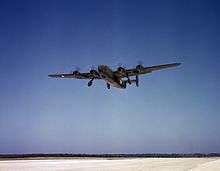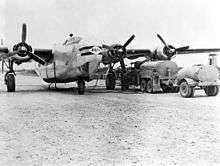Consolidated C-87 Liberator Express
| C-87 Liberator Express | |
|---|---|
 | |
| Role | Military transport aircraft |
| Manufacturer | Consolidated Aircraft |
| Introduction | 1942 |
| Status | Retired |
| Primary users | United States Army Air Forces Royal Air Force |
| Number built | 287 |
| Developed from | B-24 Liberator |
The Consolidated C-87 Liberator Express was a transport derivative of the B-24 Liberator heavy bomber built during World War II for the United States Army Air Forces. A total of 287 C-87s were built alongside the B-24 at the Consolidated Aircraft plant in Fort Worth, Texas. The plant also developed and delivered a USAAF flight engineer trainer designated as the AT-22, a United States Navy VIP transport designated as the RY, and a Royal Air Force VIP transport designated as the Liberator C.IX. The last development was a Navy contracted, single tail version with an extended fuselage. Built in San Diego the USN designation was RY-3.
Design and development
The C-87 was hastily designed in early 1942 to fulfill the need for a heavy cargo and personnel transport with longer range and better high-altitude performance than the C-47 Skytrain, the most widely available United States Army Air Forces transport aircraft at the time. Production began in 1942.
The first C-87 prototype was 41-11608. The design included various modifications, including the elimination of gun turrets and other armament along with the installation of a strengthened cargo floor, including a floor running through the bomb bay. The glassed-in bombardier compartment of the B-24 was replaced by a hinged metal cap to allow front cargo loading. A cargo door was added to the port side of the fuselage, just forward of the tail, and a row of windows was fitted along the sides of the fuselage.
The C-87 could be fitted with removable seats and racks to carry personnel or litters in place of cargo. In its final configuration, the C-87 could carry between 20 and 25 passengers or 12,000 lbs of cargo. Because of war production bottlenecks and shortages, many C-87 aircraft were fitted with turbosuperchargers producing lower boost pressure and power than those fitted to B-24s destined for combat use, and ceiling and climb rate were accordingly adversely affected.
C-87A VIP transport
In 1942 and 1943, several C-87 aircraft were converted into VIP luxury passenger transports by adding insulation, padded seats, dividers, and other accommodations. The modified aircraft was capable of carrying 16 passengers, and given the designation C-87A. One C-87A in particular, serial 41-24159, was exclusively converted in 1943 to a presidential VIP transport, the Guess Where II, intended to carry President Franklin D. Roosevelt on international trips. Had it been accepted, it would have been the first aircraft to be used in presidential service, i.e. the first Air Force One. However, the Secret Service, after a review of the C-87's controversial safety record in service, flatly refused to approve the Guess Where II for presidential carriage.[1] The Guess Where II was then used to transport senior members of the Roosevelt administration. In March 1944, the Guess Where II transported Eleanor Roosevelt on a goodwill tour of several Latin American countries.[1]
XC-87B
A damaged B-24D, 42-40355 became what is referred to as the XC-87B with and extended fuselage and low altitude engine packages. This transport, "Pinocchio" as it was known, was later converted to a single tailfin with Privateer-type engine packages. This should not be confused with the cancelled XC-87B project which proposed an armed transport.
Operational history

Most C-87s were operated by the U.S. Air Transport Command and flown by formerly civilian crews from U.S. civil transport carriers. The planes were initially used on transoceanic routes too long to be flown by the C-47. After the Japanese invasion of Burma in 1942, the C-87 was used for flying war material from India to American and Chinese forces over "The Hump", the treacherous air route that crossed the Himalayas. When the route was established, the C-87 was the only readily available American transport with high-altitude performance good enough to fly this route while carrying a large cargo load.
The C-87 was plagued by numerous problems and suffered from a poor reputation among its crews. Veteran airline pilot and author Ernest K. Gann, in his 1961 memoir Fate is the Hunter, wrote: "They were an evil bastard contraption, nothing like the relatively efficient B-24 except in appearance." Complaints centered around electrical and hydraulic system failures in extreme cold at high altitudes, a disconcertingly frequent loss of all cockpit illumination during takeoffs, and a flight deck heating system that produced either stifling heat or did not function at all.[2]
The C-87 did not climb well when heavily loaded, a dangerous characteristic when flying out of the unimproved, rain-soaked airfields of India and China; many were lost on takeoff with the loss of just a single engine. Gann's book recounts a near-collision with the Taj Mahal after takeoff in a heavily loaded C-87 when full flaps had to be hastily deployed to increase the aircraft's altitude to avoid the edifice. The aircraft's auxiliary long-range fuel tanks were linked by improvised and often leaky fuel lines that crisscrossed the crew compartment, choking flight crews with noxious gasoline fumes and creating an explosion hazard. The C-87 also had a tendency to enter an uncontrollable stall or spin when confronted with even mild icing conditions, a frequent occurrence over the Himalayas. Gann said they "could not carry enough ice to chill a highball".[3]
The aircraft could also become unstable in flight if its center of gravity shifted due to improper cargo loading. This longitudinal instability arose from the aircraft's hasty conversion from bomber to cargo transport. Unlike a normal cargo transport, which was designed from the start with a contiguous cargo compartment with a safety margin for fore-and-aft loading variations, the bomb racks and bomb bays built into the B-24 design were fixed in position, greatly limiting the aircraft's ability to tolerate improper loading. This problem was exacerbated by wartime exigencies and the failure of USAAF Air Transport Command to instruct loadmasters in the C-87's peculiarities. The design's roots as a bomber are also considered culpable for frequently collapsing nosegear; its strength was adequate for an aircraft that dropped its payload in flight before landing on a well-maintained runway, but it proved marginal for an aircraft making repeated hard landings on rugged unimproved airstrips while heavily loaded.
Despite its shortcomings and unpopularity among its crews, the C-87 was valued for the reliability of its Pratt & Whitney engines, superior speed that enabled it to mitigate significantly the effect of head and cross winds, a service ceiling that allowed it to surmount most weather fronts, and range that permitted its crews to fly "pressure-front" patterns that chased favorable winds.[4] The C-87 was never fully displaced on the air routes by the Douglas C-54 Skymaster and Curtiss C-46 Commando, which offered similar performance combined with greater reliability and more benign flight characteristics. Some surviving C-87 aircraft were converted into VIP transports or flight crew trainers, and several others were sold to the Royal Air Force.
Variants

- C-87
- USAAF transport variant of the B-24D with seats for 25 passengers, 278 built.[5]
- C-87A
- VIP version for 16 passengers, three for the USAAF and three to the United States Navy as RY-1.[5]
- C-87B
- Proposed armed variant, not built.[5]
- XC-87B
Conversions with stretched forward compartment and LB-30 type low altitude power packages. Later PB4Y-2 type power packages and single tail (see RY-3/C-87C). 42-40355. (Total: 1 conversion)
- C-87C
- Proposed USAAF variant of the RY-3, designation not used.[5]
- C-109
- Dedicated tanker version of the B-24 with six additional fuel tanks carrying 2,400 gallons of fuel.
- RY-1
- United States Navy designation for three former USAAF C-87As fitted for 16 passengers.[5]
- RY-2
- Five former USAAF C-87s fitted for 20 passengers, a further 15 were cancelled.[5]
- RY-3
- A C-87 with the single tail and seven foot fuselage stretch of the PB4Y-2 Privateer. 39 were built, and were used by the RAF Transport Command No. 231 Squadron, U.S. Marine Corps, and one was used by the RCAF.
- AT-22
- Five C-87s used for flight engineer training, later designated TB-24D.[5]
- Liberator C.IX
- Royal Air Force designation for 26 RY-3s supplied under Lend-Lease. The designation meaning "Cargo (aircraft) Mark 9"
Operators
- Indian Air Force Two C-87 aircraft recovered from an aircraft dump in Kanpur formed No.102 Survey Flight.[6]
Specifications
Data from [7]
General characteristics
- Crew: four (pilot, co-pilot, navigator, radio operator)
- Capacity: ~25 passengers or 6,000 lb (2,700 kg) of cargo for transatlantic flights and 10,000 lb (4,500 kg) max for shorter flights
- Length: 66 ft 4 in (20.22 m)
- Wingspan: 110 ft 0 in (33.53 m)
- Height: 17 ft 11 in (5.46 m)
- Wing area: 1,048 sq ft (97.4 m2)
- Empty weight: 30,645 lb (13,900 kg)
- Gross weight: 56,000 lb (25,401 kg)
- Fuel capacity: 2,910 US gal (11,000 l; 2,420 imp gal)
- Powerplant: 4 × Pratt & Whitney R-1830-43 9-cyl. air-cooled radial piston engines with General Electric turbo-superchargers, 1,200 hp (890 kW) each at 2700 rpm for take-off
Performance
- Maximum speed: 300 mph (483 km/h; 261 kn) at 25,000 ft (7,600 m)
- Range: 1,400 mi (1,217 nmi; 2,253 km) at 60% power, 215 mph (187 kn; 346 km/h) at 10,000 ft (3,000 m)
- Ferry range: 3,300 mi (2,868 nmi; 5,311 km) at 215 mph (187 kn; 346 km/h) at 10,000 ft (3,000 m)
- Service ceiling: 28,000 ft (8,500 m) at 56,000 lb (25,000 kg) take-off weight
- Time to altitude: 20,000 ft (6,100 m) in 60 minutes
See also
- Related development
- Commando (aircraft)
- Consairway
- Consolidated B-24 Liberator
- Consolidated PB4Y-2 Privateer
- R2Y Liberator Liner
- Aircraft of comparable role, configuration and era
- Related lists
- List of aircraft of World War II
- List of military aircraft of the United States
- List of military aircraft of the United States (naval)
References
- Notes
- 1 2 Dorr 2002, p. l34.
- ↑ Gann, Ernest K. (1961), Fate is the Hunter, Simon & Schuster. ISBN 0-671-63603-0, pp. 214–215
- ↑ Gann (1961), p. 214
- ↑ Gann (1961), pp. 216–217
- 1 2 3 4 5 6 7 Andrade 1987, pp. 42, 82, 87.
- ↑ "Liberator." Archived 2009-12-12 at the Wayback Machine. bharat-rakshak.com. Retrieved: 9 December 2010. Archived December 12, 2009, at the Wayback Machine.
- ↑ Baugher, Joe (13 June 2004). "Consolidated C-87 Liberator Express". joebaugher.com. Retrieved 16 September 2015.
- Bibliography
- Andrade, John. U.S. Military Aircraft Designations and Serials since 1909. Hinckley, UK: Midland Counties Publications, 1979. ISBN 0-904597-22-9.
- Baugher, Joe. "Consolidated C-87 Liberator Express". Joe Baugher's Encyclopedia of American Military Aircraft. Retrieved: 25 April 2006.
- Baugher, Joe. "Consolidated C-109". Joe Baugher's Encyclopedia of American Military Aircraft. Retrieved: 5 September 2008.
- Dorr, Robert F. Air Force One. New York: Zenith Imprint, 2002. ISBN 0-7603-1055-6.
- Gann, Ernest K. Fate is the Hunter. New York: Simon & Schuster, 1961. ISBN 0-671-63603-0.
External links
| Wikimedia Commons has media related to Consolidated C-87 Liberator Express. |
- Popular Mechanics, November 1943, "Cutaway Drawing C-87"
- Wendell Willkie arriving in Cairo 1942 on C-87 "Gulliver"... note double cargo door of genuine C-87
- C-87 photo: on unknown remote field from Thomas McAvoy's 1944 Life essay, "Fireball Express to India"
- C-87 photo: cockpit view from Thomas McAvoy's 1944 Life essay, "Fireball Express to India"
- C-87 photo: nose loading hatch from Thomas McAvoy's 1944 Life essay, "Fireball Express to India"
- C-87 photo with vintage truck from Thomas McAvoy's 1944 Life essay, "Fireball Express to India"
- C-87 pilot's view of Taj Mahal as mentioned in Ernest K. Gann reference, McAvoy/Life